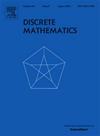Connectivity threshold for superpositions of Bernoulli random graphs
IF 0.7
3区 数学
Q2 MATHEMATICS
引用次数: 0
Abstract
Let be independent Bernoulli random subgraphs of the complete graph having variable sizes and densities . Letting , we study the connectivity threshold for the union defined on the vertex set of . Assuming that the empirical distribution of the pairs converges to a probability distribution P we show that the threshold is defined by the mixed moments . For we have is connected and for we have is connected. Interestingly, this dichotomy only holds if the mixed moment .
伯努利随机图叠加的连通性阈值
设G1,…,Gm为完全图Kn的独立伯努利随机子图,其大小为x1,…,xm∈[n],密度为q1,…,qm∈[0,1]。设n,m→+∞,我们研究了在Kn的顶点集上定义的并集∪k=1mGk的连通阈值。假设(x1,q1),…,(xm,qm)对的经验分布Pn,m收敛于一个概率分布P,我们证明阈值由混合矩κn=∑x(1−(1−q)|x−1|)Pn,m(dx,dq)定义。对于ln ln n - mnκn→−∞我们有P{∪k=1mGk是连通的}→1对于ln n - mnκn→+∞我们有P{∪k=1mGk是连通的}→0。有趣的是,这种二分法只在混合矩((1−(1−q)|x−1|)ln (1+x)P(dx,dq)<∞)下成立。
本文章由计算机程序翻译,如有差异,请以英文原文为准。
求助全文
约1分钟内获得全文
求助全文
来源期刊

Discrete Mathematics
数学-数学
CiteScore
1.50
自引率
12.50%
发文量
424
审稿时长
6 months
期刊介绍:
Discrete Mathematics provides a common forum for significant research in many areas of discrete mathematics and combinatorics. Among the fields covered by Discrete Mathematics are graph and hypergraph theory, enumeration, coding theory, block designs, the combinatorics of partially ordered sets, extremal set theory, matroid theory, algebraic combinatorics, discrete geometry, matrices, and discrete probability theory.
Items in the journal include research articles (Contributions or Notes, depending on length) and survey/expository articles (Perspectives). Efforts are made to process the submission of Notes (short articles) quickly. The Perspectives section features expository articles accessible to a broad audience that cast new light or present unifying points of view on well-known or insufficiently-known topics.
 求助内容:
求助内容: 应助结果提醒方式:
应助结果提醒方式:


